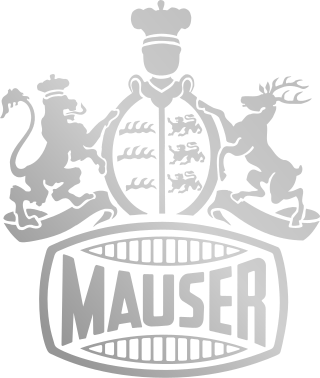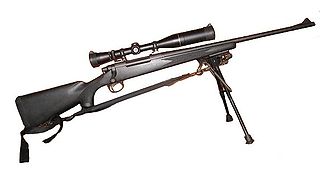
Bolt-action is a type of manual firearm action that is operated by directly manipulating the bolt via a bolt handle, which is most commonly placed on the right-hand side of the weapon.

Mauser, originally Königlich Württembergische Gewehrfabrik , was a German arms manufacturer. Their line of bolt-action rifles and semi-automatic pistols has been produced since the 1870s for the German armed forces. In the late 19th and early 20th centuries, Mauser designs were also exported and licensed to many countries which adopted them as military and civilian sporting firearms. The Gewehr 98 in particular was widely adopted and copied, and is the foundation of many of today's sporting bolt-action rifles.

The M1903 Springfield, officially the United States Rifle, Caliber .30-06, Model 1903, is an American five-round magazine-fed, bolt-action service repeating rifle, used primarily during the first half of the 20th century.

Weatherby, Inc. is an American gun manufacturer founded in 1945 by Roy Weatherby. The company is best known for its high-powered magnum cartridges, such as the .257 Weatherby Magnum, .270 Weatherby Magnum, .300 Weatherby Magnum, .340 Weatherby Magnum and the .460 Weatherby Magnum. The company's headquarters is based in Sheridan, Wyoming.

The Remington Model 700 is a series of bolt-action centerfire rifles manufactured by Remington Arms since 1962. It is a development of the Remington 721 and 722 series of rifles, which were introduced in 1948. The M24 and M40 military sniper rifles, used by the US Army and Marine Corps, respectively, are both based on the Model 700 design.
The Winchester Model 70 is a bolt-action sporting rifle. It has an iconic place in American sporting culture and has been held in high regard by shooters since it was introduced in 1936, earning the moniker "The Rifleman's Rifle". The action has some design similarities to Mauser designs and it is a development of the earlier Winchester Model 54, itself based on a Mauser 98-type action.

The Gewehr 98 is a German bolt-action rifle made by Mauser, firing cartridges from a five-round internal clip-loaded magazine. It was the German service rifle from 1898 to 1935, when it was replaced by the Karabiner 98k, a shorter weapon using the same basic design. The Gewehr 98 action, using a stripper clip loaded with the 7.92×57mm Mauser cartridge, successfully combined and improved several bolt-action engineering concepts which were soon adopted by many other countries, including the United Kingdom, United States, and Japan. The Gewehr 98 replaced the earlier Gewehr 1888 as the main German service rifle. It first saw combat in the Chinese Boxer Rebellion and was the main German infantry service rifle of World War I. The Gewehr 98 saw further military use by the Ottoman Empire and Nationalist Spain.

The M1917 Enfield, the "American Enfield", formally named "United States Rifle, cal .30, Model of 1917" is an American modification and production of the .303-inch Pattern 1914 Enfield (P14) rifle, which was developed and manufactured during the period 1917–1918. Numerically, it was the main rifle used by the American Expeditionary Forces in Europe during World War I. The Danish Sirius Dog Sled Patrol on Greenland still use the M1917, which performs reliably in Arctic conditions, as their service weapon.

The Rifle, .303 Pattern 1914 was a British service rifle of the First World War period. A bolt action weapon with an integral 5-round magazine, it was principally contract manufactured by companies in the United States. It served as a sniper rifle and as second line and reserve issue until being declared obsolete in 1947. The Pattern 1914 Enfield was the successor to the Pattern 1913 Enfield experimental rifle and the predecessor of the U.S. Rifle M1917 Enfield.
The Marlin Model 60, also known as the Marlin Glenfield Model 60, is a semi-automatic rifle that fires the .22 LR rimfire cartridge. Produced by Remington Arms in Huntsville, Alabama formerly in Mayfield, Kentucky, formerly by Marlin Firearms Company of North Haven, Connecticut, it was in continuous production from 1960 to 2020 and the company says it is the most popular rifle of its kind in the world. Major features include a micro-groove barrel, a cross-bolt safety, hardwood stock with Monte Carlo comb, and brass or blued steel inner magazine tube. The Marlin Model 795 is a very similar rifle and based on the Marlin Model 60, changed only to accept a detachable box magazine.
The Remington Model 572Fieldmaster is a manually-operated, slide-action rimfire repeating rifle manufactured by the Remington Arms Company. The 572 is noted for its similarity to the Remington 870 shotgun in design. The 572 is chambered for the .22 Short, .22 Long and .22 Long Rifle cartridges. Ammunition is supplied by a tubular magazine under the barrel which holds 15-22 rounds depending on the cartridge used. The longevity of manufacture speaks well of the popularity and durability of the action, and the overall reliability of this gun. It is popular with "plinkers" and collectors both, along with being a good small game, or "camp" rifle.

The CZ 527 is a bolt-action smallbore rifle designed by Česká zbrojovka Uherský Brod. CZ discontinued production in 2021. There are numerous different designs and stylings. The available calibers are the following: .17 Remington, .17 Hornet, .22 Hornet, .204 Ruger, .221 Fireball, .222 Remington, .223 Remington, 6.5mm Grendel, .300 AAC Blackout and 7.62×39mm.

The 6mm Remington rifle cartridge, originally introduced in 1955 by Remington Arms Company as the .244 Remington, is based on a necked down .257 Roberts cartridge using a .24/6mm bullet. Known for a combination of high velocity, long range, flat trajectory, and accuracy, it is suitable as a dual use hunting cartridge for both medium-sized big game and varmints. When used in the less common earlier slow twist barrels, it offers exceptional range for varmint applications. While not as commercially popular today as the .243 Winchester, the 6mm Remington enjoys a slight ballistic advantage and continues to be popular with handloaders and custom rifle builders.
The Remington Model 30 is a US sporting rifle of the inter-war period based on the military P14/M1917 Enfield rifle action, which was manufactured for the British and US governments during World War I. Initial specimens used surplus military parts with some modifications in order to consume the stock of parts, though further modifications were made as production progressed and later rifles were produced from newly manufactured parts. Most early rifles were in the military .30-06 calibre used in the M1917 but it became available in a variety of chamberings. It was the first high-powered bolt-action sporting rifle produced by Remington.
The Remington Model 552Speedmaster is a blow-back operated, self-loading, semi-automatic rifle that can fire .22 Short, .22 Long and .22 long rifle cartridges. Ammunition is fed from a tubular magazine under the barrel.
The CZ-550 is a bolt-action hunting rifle series manufactured by Česká zbrojovka Uherský Brod. The CZ 550 series is available with a medium or magnum sized action. The CZ 550 rifle is based on the Mauser 98 rifle.
The Mauser M 98 are a series of currently (2020) produced bolt-action hunting rifles. The production of the controlled round feed Mauser 98 bolt action system for the German military ceased at the end of World War II in 1945. The new Mauser M 98 and M 98 Magnum rifles for civil users are in production since 1999 in Isny im Allgäu, Germany by Mauser Jagdwaffen GmbH, according to original drawings of 1936 and the respective Mauser patents. Mauser Jagdwaffen GmbH is a subsidiary of SIG Sauer.
The BSA CF2 is a rifle manufactured by the Birmingham Small Arms Company (BSA).
The Remington Model 572 Fieldmaster is a slide action, manually-operated .22 caliber (rimfire) rifle manufactured by Remington Arms Company. First introduced to the commercial market in 1956, the 572 Fieldmaster rifle incorporates a tubular magazine capable of feeding .22 Short, .22 Long, or .22 Long Rifle rimfire cartridges, a cross-bolt safety, and an aluminum receiver grooved for scope mounts. The original Fieldmaster used a 22.75-inch barrel. The Model 572 uses many of the design features first introduced on the Remington Model 870 shotgun, and replaced the Model 121 Fieldmaster as the company's slide-action rimfire repeater.
Lynx Rifles is a brand of high-end straight pull rifles manufactured by Finnish firearms manufacturerer Pirkan ASE both for the hunting, sport and tactical market. All rifles are handmade in Finland and feature a biathlon style cross bolt straight pull system consisting of relatively few parts.














